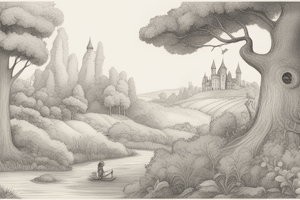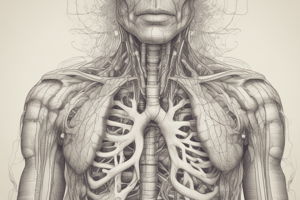Podcast
Questions and Answers
Quale volume d'aria rappresenta la quantità massima che può essere espulsa dai polmoni dopo una normale espirazione?
Quale volume d'aria rappresenta la quantità massima che può essere espulsa dai polmoni dopo una normale espirazione?
- Volume residuo
- Capacità vitale
- Volume di riserva inspiratorio
- Volume di riserva espiratorio (correct)
Quale componente del sistema nervoso centrale è principalmente responsabile del controllo involontario della respirazione?
Quale componente del sistema nervoso centrale è principalmente responsabile del controllo involontario della respirazione?
- Cervelletto
- Talamo
- Ippocampo
- Midollo allungato (correct)
Quali recettori sono responsabili del monitoraggio dei livelli di ossigeno, anidride carbonica e pH nel sangue?
Quali recettori sono responsabili del monitoraggio dei livelli di ossigeno, anidride carbonica e pH nel sangue?
- Termocettori
- Fotocettori
- Chemiocettori (correct)
- Barocettori
Quale tra le seguenti condizioni respiratorie è principalmente associata all'infiammazione e al restringimento delle vie aeree, spesso causata da reazioni allergiche?
Quale tra le seguenti condizioni respiratorie è principalmente associata all'infiammazione e al restringimento delle vie aeree, spesso causata da reazioni allergiche?
Quale volume d'aria indica la quantità che rimane nei polmoni dopo un'espirazione forzata?
Quale volume d'aria indica la quantità che rimane nei polmoni dopo un'espirazione forzata?
Quale delle seguenti strutture NON fa parte del tratto respiratorio superiore?
Quale delle seguenti strutture NON fa parte del tratto respiratorio superiore?
Qual è il ruolo principale degli alveoli nel sistema respiratorio?
Qual è il ruolo principale degli alveoli nel sistema respiratorio?
Cosa accade al diaframma durante l'inspirazione?
Cosa accade al diaframma durante l'inspirazione?
Come avviene lo scambio di gas negli alveoli?
Come avviene lo scambio di gas negli alveoli?
Quale dei seguenti fattori regola la frequenza respiratoria?
Quale dei seguenti fattori regola la frequenza respiratoria?
Qual è la funzione principale della laringe?
Qual è la funzione principale della laringe?
Quale di questi non è un volume o una capacità respiratoria?
Quale di questi non è un volume o una capacità respiratoria?
Quale processo determina l'ingresso dell'aria nei polmoni durante l'inspirazione?
Quale processo determina l'ingresso dell'aria nei polmoni durante l'inspirazione?
Flashcards
Volume di riserva espiratoria
Volume di riserva espiratoria
La quantità di aria che può essere espirata con forza aggiuntiva dopo una normale espirazione.
Volume residuo
Volume residuo
La quantità di aria che rimane nei polmoni dopo una espirazione forzata.
Capacità vitale
Capacità vitale
La quantità massima di aria che può essere spostata dentro e fuori dai polmoni in un singolo respiro.
Come funziona la respirazione?
Come funziona la respirazione?
Signup and view all the flashcards
Malattie respiratorie
Malattie respiratorie
Signup and view all the flashcards
Funzione del sistema respiratorio
Funzione del sistema respiratorio
Signup and view all the flashcards
Strutture del sistema respiratorio
Strutture del sistema respiratorio
Signup and view all the flashcards
Alveoli e scambio gassoso
Alveoli e scambio gassoso
Signup and view all the flashcards
Inspirazione ed espirazione
Inspirazione ed espirazione
Signup and view all the flashcards
Tratto respiratorio superiore
Tratto respiratorio superiore
Signup and view all the flashcards
Funzione del naso
Funzione del naso
Signup and view all the flashcards
Trachea e bronchi
Trachea e bronchi
Signup and view all the flashcards
Scambio gassoso negli alveoli
Scambio gassoso negli alveoli
Signup and view all the flashcards
Study Notes
General Overview
- The respiratory system is responsible for gas exchange: taking in oxygen (O2) and releasing carbon dioxide (CO2).
- It consists of a network of structures that facilitate this process, including the nose, pharynx, larynx, trachea, bronchi, and lungs.
- The lungs contain millions of alveoli specialized for gas exchange.
- The process of respiration involves both inhalation (breathing in) and exhalation (breathing out).
Upper Respiratory Tract
- The upper respiratory tract includes the nose, nasal cavity, pharynx, and larynx.
- The nose warms, humidifies, and filters inhaled air.
- The nasal cavity contains olfactory receptors for smell.
- The pharynx (throat) is a passageway for both air and food.
- The larynx (voice box) houses the vocal cords and plays a crucial role in sound production.
Lower Respiratory Tract
- The lower respiratory tract includes the trachea, bronchi, and lungs.
- The trachea (windpipe) is a tube that carries air to the bronchi.
- The bronchi are two branches that divide further into smaller bronchioles within the lungs.
- The lungs are the primary organs of gas exchange, composed of millions of alveoli.
- Alveoli are tiny air sacs surrounded by a network of capillaries where gas exchange takes place.
Mechanics of Breathing
- Breathing is a mechanical process driven by changes in pressure within the thoracic cavity (chest cavity).
- Inhalation occurs when the diaphragm contracts and the rib cage expands, creating a lower pressure inside the lungs, drawing air in.
- Exhalation occurs when the diaphragm relaxes and the rib cage recoils, increasing pressure in the lungs and forcing air out.
- Breathing is regulated by the respiratory center in the brain, which responds to changes in blood chemistry (e.g., CO2 levels).
Gas Exchange
- Gas exchange in the alveoli relies on diffusion.
- Oxygen from the inhaled air diffuses across the alveolar membrane and into the bloodstream.
- Carbon dioxide from the blood diffuses into the alveoli and is expelled during exhalation.
- The process is facilitated by the high surface area of the alveoli and the thin nature of the alveolar membrane.
Respiratory Volumes and Capacities
- Respiratory volumes and capacities describe the quantity of air exchanged during breathing.
- Tidal volume is the volume of air inhaled or exhaled in a normal breath.
- Inspiratory reserve volume is the additional volume of air that can be inhaled forcibly.
- Expiratory reserve volume is the additional volume of air that can be exhaled forcibly.
- Residual volume is the amount of air remaining in the lungs after forceful exhalation.
- Vital capacity is the maximum amount of air that can be moved in and out of the lungs in a single breath.
Control of Respiration
- Breathing is largely involuntary and controlled by the respiratory center in the medulla oblongata of the brain, and in the pons also.
- Chemoreceptors in the brain and blood vessels monitor blood levels of oxygen, carbon dioxide, and pH.
- These chemoreceptors trigger adjustments in breathing rate and depth to maintain homeostasis.
- External factors like exercise, emotions, and altitude also influence respiration.
Diseases Affecting the Respiratory System
- Various diseases can affect the respiratory system, including infections (e.g., pneumonia, bronchitis), allergies (e.g., asthma), and chronic conditions (e.g., emphysema, chronic bronchitis).
- These conditions can impair gas exchange, causing breathing difficulties and health issues.
- Lifestyle choices such as smoking significantly increase the risk of respiratory diseases.
Studying That Suits You
Use AI to generate personalized quizzes and flashcards to suit your learning preferences.




